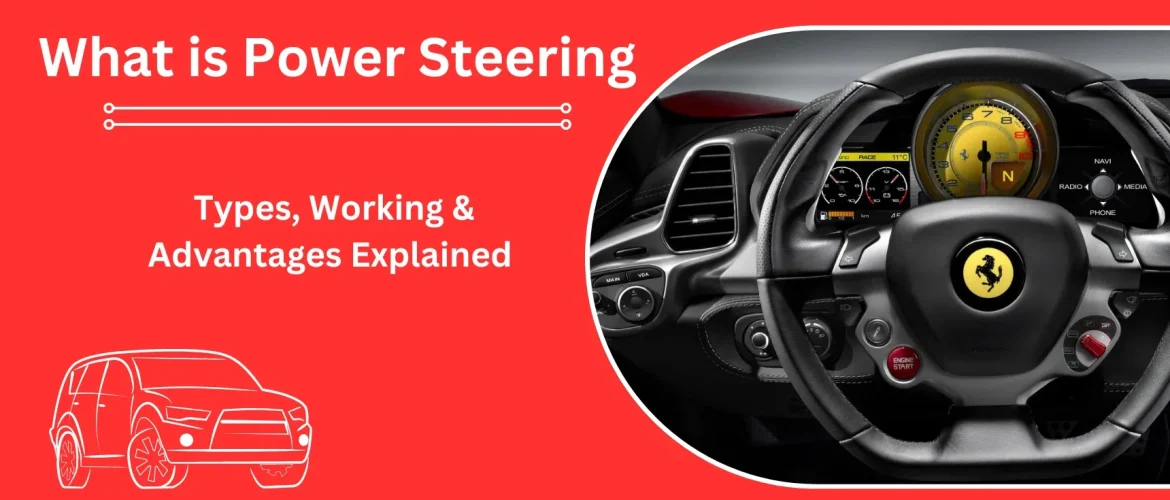Picture yourself cruising down the highway, effortlessly manoeuvring your car with just a gentle touch of the steering wheel. Ever wondered what makes this seamless control possible? That’s the magic of power steering! In this guide, we’ll delve into the nitty-gritty of power steering – its types, how it works, the perks it offers, and much more.
Introduction to Power Steering
Definition of Power Steering:
Simply put, power steering is a system in your vehicle that assists in steering by augmenting the force applied to the steering wheel. It’s like having a helping hand, making steering smoother and more manageable.
Importance in Automobiles:
Power steering isn’t just a luxury; it’s a safety feature that has become indispensable in modern vehicles. Imagine wrestling with a heavy steering wheel while trying to navigate through tight turns or parking spots – not a pleasant thought, right? That’s where power steering swoops in to save the day.
Types of Power Steering Systems
Hydraulic Power Steering:
Traditionally, hydraulic power steering systems have been the go-to choice in vehicles. They rely on hydraulic fluid and a pump to assist in steering, providing a hydraulic boost that reduces the effort required to turn the wheel.
Electric Power Steering:
In recent years, electric power steering (EPS) has gained popularity due to its efficiency and flexibility. EPS systems use an electric motor to provide steering assistance, eliminating the need for hydraulic fluid and pumps.
Electro-Hydraulic Power Steering:
Combining the best of both worlds, electro-hydraulic power steering (EHPS) integrates hydraulic systems with electric controls. This hybrid approach offers the benefits of both hydraulic and electric power steering.
How Does Power Steering Work?

Hydraulic Power Steering Mechanism:
In hydraulic power steering systems, when you turn the steering wheel, a hydraulic pump pressurizes the fluid, which then exerts force on the steering gear or rack, aiding in steering.
Electric Power Steering Mechanism:
Electric power steering systems utilize sensors to detect steering inputs from the driver, which are then processed by an electronic control unit (ECU). The ECU directs an electric motor to apply assistance to the steering column, making steering effortless.
Advantages of Power Steering

Enhanced Steering Control:
With power steering, drivers experience enhanced control over their vehicles, especially in challenging driving conditions like tight corners or rough terrains.
Reduced Steering Effort:
Gone are the days of arm-wrenching manoeuvres! Power steering significantly reduces the physical effort required to turn the wheel, resulting in a more comfortable driving experience.
Improved Fuel Efficiency:
Believe it or not, power steering can contribute to better fuel economy by optimizing steering effort, thus reducing the strain on the engine.
Maintenance Tips for Power Steering Systems

Regular Fluid Checks:
Maintaining proper fluid levels is crucial for the smooth operation of power steering systems. Regularly check the power steering fluid and top it up as needed.
Steering System Inspections:
Periodic inspections of the steering system can help detect any issues early on, preventing potential breakdowns and costly repairs.
Prompt Repairs of Leaks:
If you notice any leaks or unusual noises coming from the steering system, don’t ignore them! Addressing these issues promptly can prevent further damage and ensure your safety on the road.
Common Power Steering Problems and Solutions
Fluid Leaks:
Leaking power steering fluid can lead to decreased steering performance and potential damage to the system. Identifying and repairing leaks promptly is crucial to avoid further complications.
Noisy Steering:
Unusual noises such as whining or squealing when turning the steering wheel could indicate issues with the power steering pump or fluid levels. Consult a mechanic to diagnose and resolve the issue.
Stiff Steering:
Difficulty in turning the steering wheel, especially at low speeds, may indicate problems with the power steering system. This could be due to low fluid levels, a faulty pump, or steering rack issues.
Future Trends in Power Steering Technology
Integration with Autonomous Driving:
As we move towards an era of autonomous vehicles, power steering systems will play a vital role in facilitating smooth and precise vehicle control, seamlessly integrating with advanced driver-assistance systems (ADAS).
Advancements in Electric Power Steering:
With ongoing advancements in electric power steering technology, we can expect even greater efficiency, responsiveness, and customization options in future vehicles.
Conclusion
Power steering has revolutionized the way we drive, making steering effortless and enjoyable. Whether it’s navigating through city streets or cruising on the open road, power steering ensures a smoother and safer driving experience. By understanding the different types of power steering systems, how they work, and their advantages, you can appreciate the ingenuity behind this essential automotive feature.
FAQs (Frequently Asked Questions)
1. How do I know if my power steering system is failing?
Signs of a failing power steering system include stiff steering, whining noises, or fluid leaks under the vehicle.
2. Can I drive my car if the power steering fails?
While it’s technically possible to drive with manual steering in case of power steering failure, it can be extremely challenging and unsafe, especially at low speeds or when parking.
3. How often should I replace my power steering fluid?
It’s recommended to replace the power steering fluid every 30,000 to 50,000 miles, but it’s always best to consult your vehicle’s manual for specific maintenance intervals.
4. Are there any DIY fixes for power steering problems?
While some minor power steering issues like low fluid levels can be addressed DIY, it’s advisable to consult a professional mechanic for more complex problems to ensure proper diagnosis and repairs.
5. Can power steering systems be upgraded or customized?
Yes, there are aftermarket options available for upgrading or customizing power steering systems, such as performance-oriented electric power steering kits or retrofitting classic vehicles with modern power steering technology.






